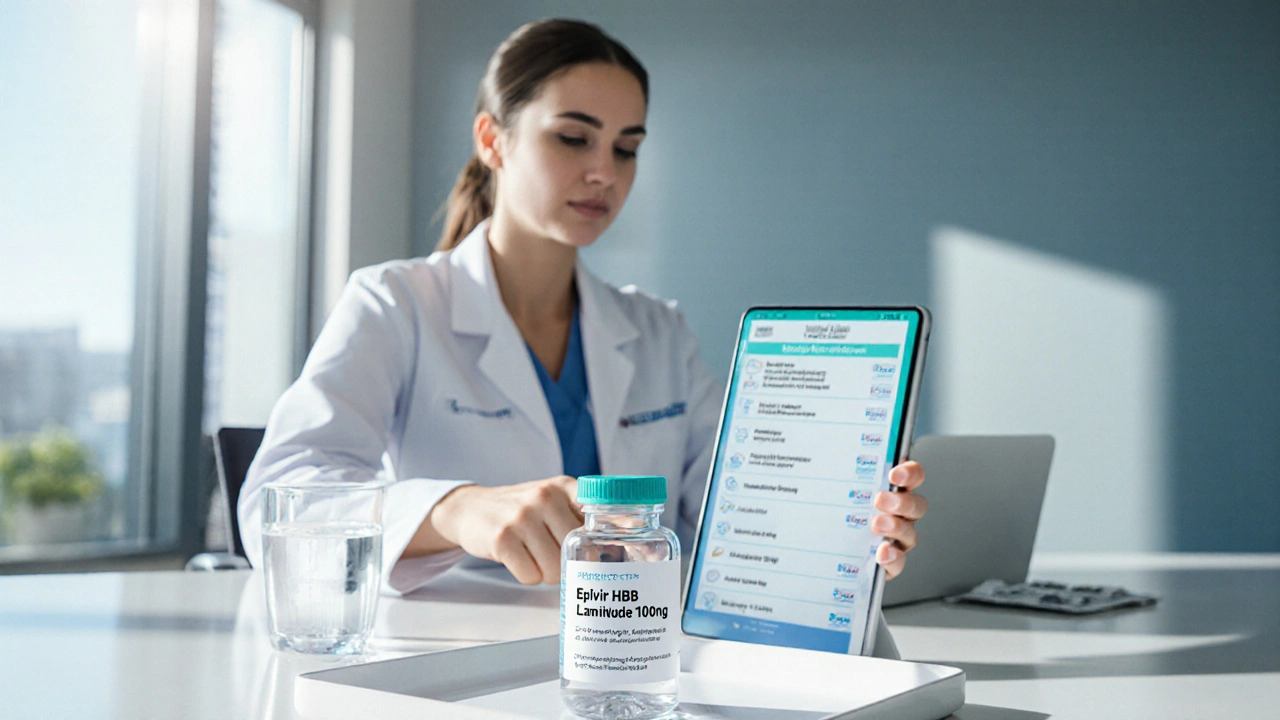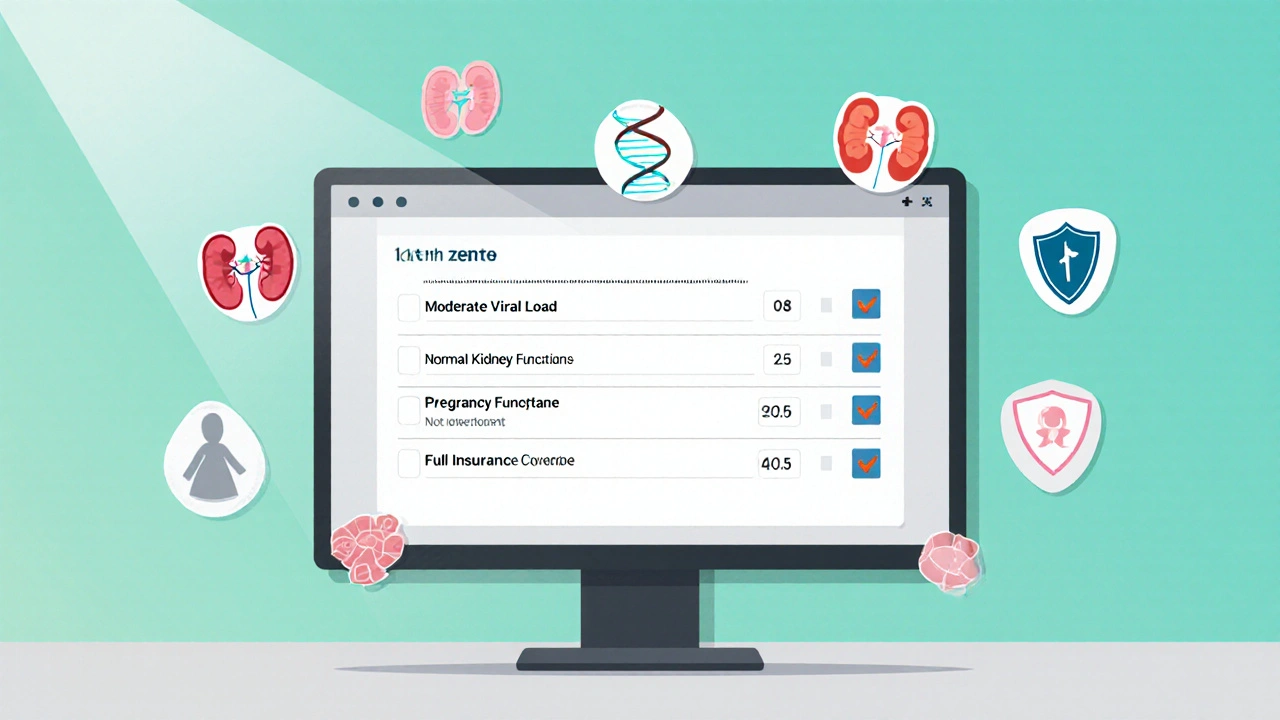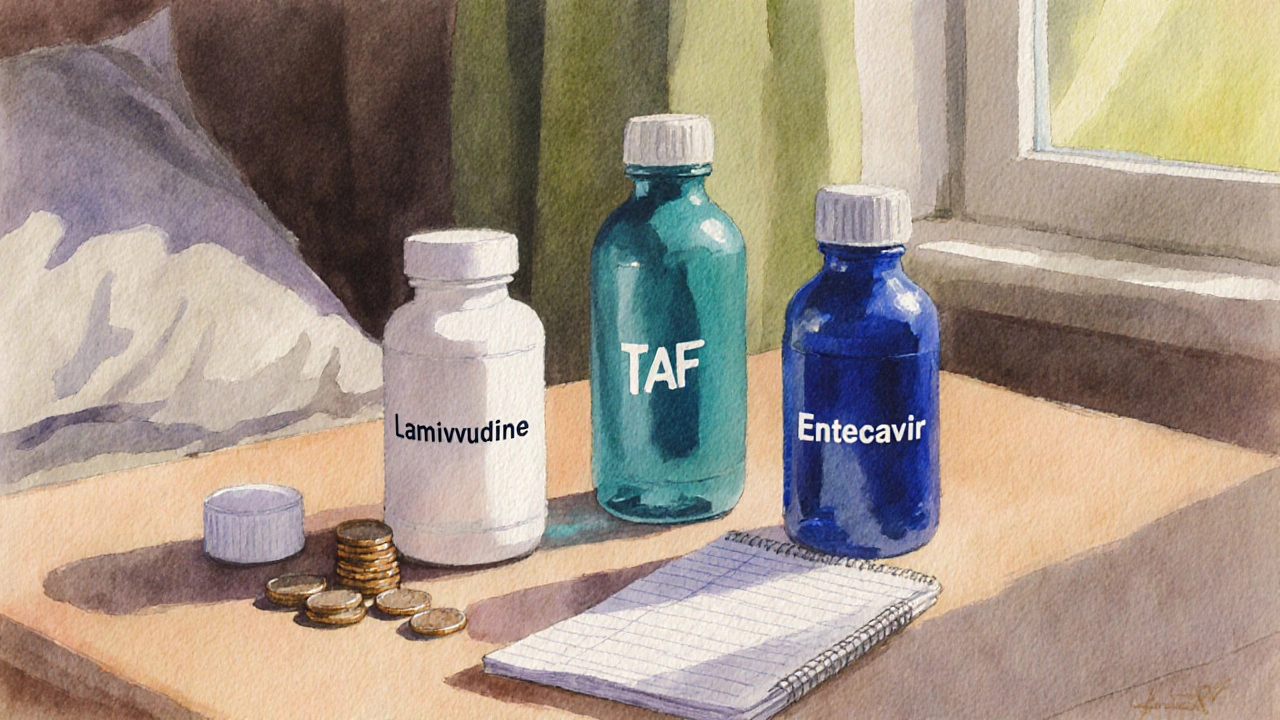Epivir HBV (Lamivudine) vs Alternative HBV Treatments: Pros, Cons & Costs
 Oct, 1 2025
Oct, 1 2025
HBV Treatment Comparison Tool
TL;DR
- Epivir HBV (Lamivudine) is cheap and well‑tolerated but has a higher resistance rate than newer agents.
- Tenofovir (TDF/TAF) and Entecavir are first‑line in most guidelines because they suppress HBV DNA more reliably.
- Pregnant patients often stay on Lamivudine due to safety data, while renal‑impaired patients may prefer Entecavir or TAF.
- Cost differences in NZ 2025 range from NZ$30/month (Lamivudine) to NZ$180/month (TAF).
- Choosing the right drug hinges on viral load, liver disease stage, kidney function, and insurance coverage.
What is Epivir HBV (Lamivudine)?
Epivir HBV is the brand name for Lamivudine, a nucleoside analogue that blocks the hepatitis B virus polymerase.
Key attributes:
- Approved dose: 100mg once daily.
- Oral tablet, taken with or without food.
- Long‑term safety profile is good; common side effects are mild headache and fatigue.
- Resistance emerges in roughly 20‑30% of patients after 2‑3years of therapy.
Top Alternatives on the Market
Guidelines from the WHO and AASLD currently list three newer antivirals as first‑line options:
- Tenofovir disoproxil fumarate (TDF) - a nucleotide analogue with a high barrier to resistance.
- Tenofovir alafenamide (TAF) - same mechanism as TDF but delivers lower kidney and bone exposure.
- Entecavir - a guanosine analogue that also resists resistance.
Older agents still used in niche scenarios include Adefovir dipivoxil and Pegylated Interferon alfa‑2a. They are less common because of modest efficacy or injection‑only routes.
Head‑to‑Head Comparison
| Attribute | Epivir HBV (Lamivudine) | TenofovirDF (TDF) | TenofovirAF (TAF) | Entecavir |
|---|---|---|---|---|
| Mechanism | DNA‑polymerase inhibitor (nucleoside) | Nucleotide analogue (reverse‑transcriptase inhibitor) | Same as TDF, but pro‑drug design reduces systemic exposure | Guanosine analogue, high affinity for HBV polymerase |
| Standard dose | 100mg PO daily | 300mg PO daily | 25mg PO daily | 0.5mg PO daily |
| HBV DNA suppression (≥2log drop) | ~70% at 48weeks | ~90% at 48weeks | ~92% at 48weeks | ~88% at 48weeks |
| Resistance after 2years | 20‑30% | <1% | <1% | ~2% |
| Renal safety | Generally safe | Potential decline in eGFR, monitor | Improved renal profile vs TDF | Excellent renal safety |
| Pregnancy category | Category B (widely used) | Category B (data supportive) | Category B (limited data) | Category B |
| Average monthly cost (NZ$) | 30±5 | 120±20 | 180±25 | 150±20 |

When to Choose Epivir HBV vs the Newer Agents
Patients don’t all need the most expensive drug. Here are three typical scenarios:
- Pregnant or planning pregnancy: Lamivudine’s long track record and safety data make it a reasonable first choice, especially if viral load is modest.
- Limited insurance coverage or high out‑of‑pocket cost: The low price of Epivir HBV can keep therapy affordable while still achieving decent viral suppression.
- History of antiviral resistance: If the patient previously failed Lamivudine, switching to Tenofovir (TDF/TAF) or Entecavir is advised because they retain activity against Lamivudine‑resistant strains.
Conversely, patients with high baseline HBV DNA (>10⁶IU/mL), advanced fibrosis, or chronic kidney disease usually start with TenofovirTAF or Entecavir to maximise suppression and minimise renal impact.
Managing Resistance and Side Effects
Lamivudine resistance typically involves the YMDD mutation in the polymerase gene. If the viral load rises after two years, the recommended approach is to add or switch to a high‑barrier drug (TDF/TAF or Entecavir). Monitoring HBV DNA every 3‑6months helps catch resistance early.
Common side effects of Lamivudine are mild, but clinicians should watch for:
- Headache or fatigue - usually transient.
- Elevated liver enzymes - may signal hepatitis flare; adjust therapy if needed.
- Rare lactic acidosis - check lactate if patients develop unexplained nausea.
Renal monitoring is still advisable, especially in older adults, even though Lamivudine has low nephrotoxicity.
Cost, Insurance, and Access in NewZealand (2025)
Pharmaceutical Benefits Scheme (PBS) subsidises all four agents, but the subsidy level varies. As of March2025:
- Lamivudine is listed under the general PBS with a co‑payment of NZ$5 per month.
- TenofovirDF receives a higher subsidy for patients with documented renal risk.
- TAF is only covered for those with proven resistance to TDF or contraindications.
- Entecavir is subsidised for patients with high viral load or cirrhosis.
Patients without a subsidy can obtain Lamivudine from online dispensaries at roughly NZ$30/month, while TAF cost can exceed NZ$200 if paid out‑of‑pocket.
Quick Decision Checklist
- Is the patient pregnant or planning pregnancy? → Consider Lamivudine first.
- Baseline HBV DNA >10⁶IU/mL? → Prefer TenofovirTAF or Entecavir.
- eGFR <60mL/min/1.73m²? → Avoid TDF; choose TAF or Entecavir.
- History of Lamivudine resistance? → Switch to Tenofovir or Entecavir.
- Budget constraints? → Lamivudine offers the lowest out‑of‑pocket cost.

Frequently Asked Questions
Can I stop Lamivudine once my liver enzymes normalize?
No. Chronic HBV requires lifelong suppression unless you achieve a functional cure (HBsAg loss). Stopping therapy often leads to viral rebound and liver inflammation.
Is Lamivudine safe for children?
Yes, it’s approved for children aged 2years and older at a weight‑adjusted dose. Monitoring for resistance is still essential.
How fast does Lamivudine reduce HBV DNA?
Typical reductions are 1‑2log copies within the first 12weeks, reaching about a 70% suppression rate by week48.
What should I do if my doctor switches me from Lamivudine to Tenofovir?
Continue Lamivudine for the first week, then start Tenofovir as directed. This overlap minimizes the risk of viral breakthrough during the switch.
Are there any drug‑drug interactions with Lamivudine?
Lamivudine has a low interaction profile. It can be taken with most antivirals, antiretrovirals, and common chronic disease meds without dose adjustment.

Chidi Anslem
October 1, 2025 AT 20:39Reading through the comparison, I appreciate how the tool balances efficacy, safety, and cost. It reminds me that health decisions often sit at the crossroads of science and lived experience. While Lamivudine offers affordability, its higher resistance rate suggests a need for vigilant monitoring. For patients in resource‑limited settings, the lower price can be a lifeline, yet the long‑term implications should not be ignored. Ultimately, the choice must reflect both clinical data and the individual's circumstances.
Holly Hayes
October 6, 2025 AT 11:46its not ok to just go for the cheapest drug it shows u dont care about the long term health costs
Penn Shade
October 11, 2025 AT 02:52Let’s be clear: the data overwhelmingly support tenofovir and entecavir as first‑line agents. Lamivudine’s moderate suppression (≈70% at 48 weeks) and 20‑30% resistance after two years place it behind the newer nucleos(t)ide analogues. For patients with high viral loads or those at risk of resistance, TDF, TAF, or entecavir provide a higher barrier and better viral kinetics. Cost‑effectiveness analyses still favor the newer agents when you factor in downstream resistance management.
Jennifer Banash
October 15, 2025 AT 17:59Esteemed colleagues, permit me to elucidate the gravitas of this therapeutic conundrum with the solemnity it demands.
First, one must acknowledge the historic triumph of Lamivudine, a stalwart once heralded as a beacon of affordability.
Nonetheless, the inexorable march of virology has unveiled its Achilles’ heel: a formidable propensity for resistance, looming at twenty to thirty percent after merely two to three years of diligent adherence.
Contrast this with the indomitable fortresses of Tenofovir disoproxil fumarate and its refined counterpart, Tenofovir alafenamide, whose low‐resistance profiles render them paragons of modern prophylaxis.
Entecavir, too, ascends as a veritable leviathan, wielding a high barrier to mutational escape while delivering robust viral suppression.
Their superior efficacy, however, exacts a fiscal toll, with monthly expenditures dwarfing the modest coffers demanded by Lamivudine.
In the theatre of clinical decision‑making, one must weigh the immediacy of cost against the specter of future therapeutic failures.
Pregnant patients, for whom safety data remain paramount, may yet find solace in Lamivudine’s established teratogenic profile.
Conversely, individuals beset by renal compromise are judiciously steered towards TAF or Entecavir, where nephrotoxicity is mitigated.
Thus, the clinician’s art lies in harmonizing pharmacologic potency, patient comorbidities, and economic realities.
Let us, therefore, eschew a monolithic approach, embracing a nuanced paradigm that accords each patient a bespoke regimen.
In summation, whilst Lamivudine’s economical allure cannot be dismissed, its long‑term virologic frailty mandates circumspection.
Jennifer Pavlik
October 20, 2025 AT 09:06Here’s a quick take: if the budget is tight, lamivudine can work, but watch for resistance. If you can afford it, tenofovir or entecavir give better control and less chance of the virus bouncing back.
Jacob Miller
October 25, 2025 AT 00:12I see you mentioned tenofovir as the superior choice, but many patients I’ve spoken with can’t even afford that option. It feels like we’re ignoring the real-world constraints that shape treatment decisions.
Debra Cine
October 29, 2025 AT 14:19Great summary! 😊 It’s awesome to see the tool lay out the pros and cons so clearly. For anyone juggling cost and efficacy, this can be a real lifesaver. 👍
Rajinder Singh
November 3, 2025 AT 05:26Indeed, the dramatics of cost versus efficacy play out like a Shakespearean tragedy, yet the curtain must rise on a solution that safeguards renal function without bankrupting the patient. The elegance of TAF in preserving kidney health is a performance worthy of applause.
Samantha Leong
November 7, 2025 AT 20:32I totally understand how overwhelming all these options can feel. Remember, you’re not alone-talking with your healthcare team and loved ones can help you navigate the best path forward.
Taylor Van Wie
November 12, 2025 AT 11:39Our country deserves the best, not cheap knock‑offs that let the virus run wild. We must push for top‑tier antivirals and refuse to settle for subpar, low‑cost treatments.
carlee Lee
November 17, 2025 AT 02:46Lamivudine is cheap.
chuck thomas
November 21, 2025 AT 17:52Curious minds wonder: could combining lifestyle interventions with a lower‑cost drug still achieve viral suppression in low‑risk patients? It’s worth exploring, especially where resources are limited.
Gareth Pugh
November 26, 2025 AT 08:59Picture this: a budget‑friendly regimen that still packs a punch-lamivudine, if wielded wisely, can be a clever, cost‑effective ally in the antiviral arsenal.
Illiana Durbin
December 1, 2025 AT 00:06When counseling patients, emphasize that while lamivudine offers affordability, regular monitoring for resistance is essential. Pair this with education on adherence, and you can mitigate many of the downsides while keeping treatment accessible.